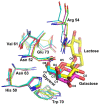Binding of Glycerol to Human Galectin-7 Expands Stability and Modulates Its Functions
- PMID: 36293173
- PMCID: PMC9604435
- DOI: 10.3390/ijms232012318
Binding of Glycerol to Human Galectin-7 Expands Stability and Modulates Its Functions
Abstract
Glycerol is seen in biological systems as an intermediate in lipid metabolism. In recent years, glycerol has been reported to act as a chemical chaperone to correct the conformation of proteins. Here, we investigate the role of glycerol in galectin-7 (Gal-7). The thermal shift and CD assays showed that the thermal stability of Gal-7 increased with glycerol concentration but with little secondary structure changes induced by glycerol. In addition, glycerol can inhibit Gal-7-mediated erythrocyte agglutination. We also solved the crystal structures of human Gal-7 in complex with glycerol in two different conditions. Glycerol binds at the carbohydrate-recognition binding sites of Gal-7, which indicates glycerol as a small ligand for Gal-7. Surprisingly, glycerol can bind a new pocket near the N-terminus of Gal-7, which can greatly reduce the flexibility and improve the stability of this region. Moreover, overexpression of Gal-7 decreased the intracellular triglyceride levels and increased mRNA expression of aquaporin-3 (AQP-3) when HeLa cells were incubated with glycerol. These findings indicate that Gal-7 might regulate glycerol metabolism. Overall, our results on human Gal-7 raise the perspective to systematically explore this so far unrecognized phenomenon for Gal-7 in glycerol metabolism.
Keywords: aquaporin-3; crystal structure; galectin-7; glycerol; stability.
Conflict of interest statement
The authors declare no conflict of interest.
Figures






References
-
- Klyosov A.A., Witczak Z.J., Platt D. Galectins. John Wiley & Sons; New York, NY, USA: 2008.
MeSH terms
Substances
Grants and funding
- BK20210902/Natural Science Foundation of Jiangsu Province in China
- 21KJB180002/Natural Science Fund for Colleges and Universities in Jiangsu Province
- 202110313046Y/Innovation and Entrepreneurship Training Program for College Students in Jiangsu Province
- 202210313002Z/Innovation and Entrepreneurship Training Program for College Students in Jiangsu Province
LinkOut - more resources
Full Text Sources

